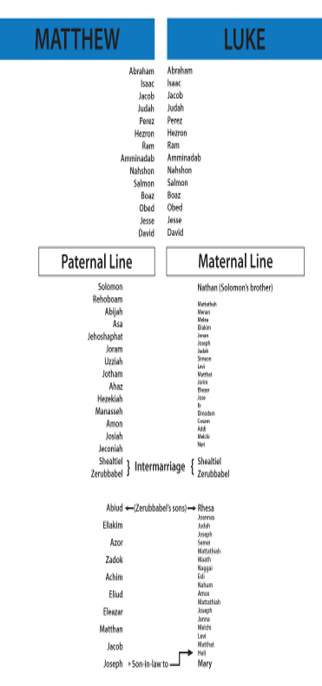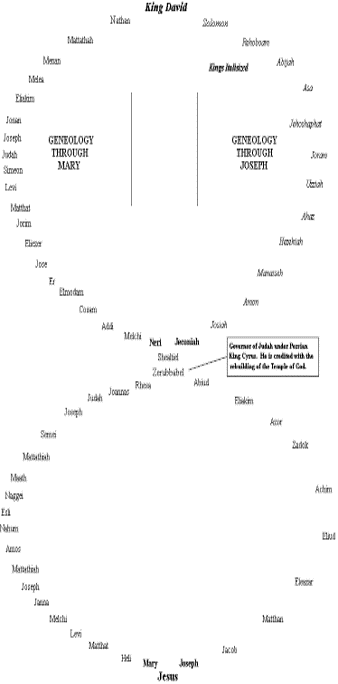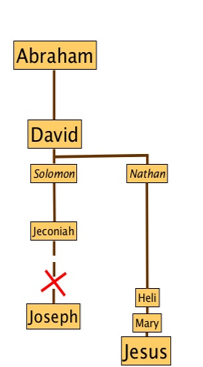Behold the King
“Confirming Jesus as the King”
Matthew 1:1-17
Matthew Levi was a tax collector. Even though he did not extort the people as other tax collectors did, he was still very much despised by his own people, the Jews.
- In Matthew 9:9, Matthew introduced himself into his gospel narrative by describing his encounter with Jesus.
- He was sitting at his “toll booth” on the road going out of Capernaum when Jesus passed by and saw him.
- Matthew was not praying that Jesus would stop, for he had not heard Jesus preach, nor is there any indication that he knew all Jesus had done that day to convince His followers that He was the Messiah: The Savior sent from God.
- But when Jesus said unto him, “Follow Me,” without any hesitation or reservation, Matthew got up from his table, left his fortune and his future fortunes, and became a devoted disciple of Christ.
|
Matthew’s purpose in his modest introduction of himself was not to show what he gave up or what he gained by following Jesus Christ, but to explain the power of Christ to transform a man from the inside out, and to create within him a new desire for the Kingdom of God.
|
Matthew wrote his gospel to prove to his fellow Jews, especially the more educated and wealthy ones, that Jesus was the long-expected and much-anticipated King. In these 28 chapters, Matthew presents Jesus as:
- The King Revealed – His birth, His life, His ministry; even his enemies revealed His kingship.
- The King Rejected – from His conception to His crucifixion, the cloud of rejection hovered over Him, even as it still does today, 2000 years later.
- The King Returning – of the four gospels, Matthew provides the intricate details of the second coming of Jesus Christ to validate Jesus as the King who will establish His kingdom upon the earth for 1,000 years.
1. The Genealogy of Jesus – Matthew 1:1-17
If Jesus was to be accepted as the King the Jews were looking for, His genealogy had to be from the Royal line.
- A person’s pedigree was critical to the Jews.
- They needed to know the heritage of a person’s tribe, their family, and their father’s house, primarily because of the issues with the land.
- Joseph and Mary had to go to Bethlehem in Judea for the census because Joseph was from the “house of David.”
- The Apostle Paul, in defending his pedigree, said he was an Israelite, from the seed of Abraham and the tribe of Benjamin.
- Matthew claimed that Jesus was the only one who could declare to be the rightful heir of David’s throne.
The two genealogies of Jesus in the New Testament.
- In Luke, we see the ascending record of Jesus’ family tree, beginning with Him being born to Mary and going 77 generations back to Adam – the maternal line.
- Luke’s goal was to prove Jesus’ humanity. While Jesus was born of a Jewish mother, He was, in fact, the Son of God, and therefore the Savior of all men.
- In Matthew, we see the descending record of Jesus’ family tree, beginning with Abraham and going down 42 generations to Joseph– the paternal line.
- Matthew’s goal was to prove Jesus’ royalty or kingly lineage; His deity, and therefore His right to inherit the throne of His father, David.
|

|
 |
|
Jeconiah, a wicked king, burned a scroll of Jeremiah’s prophecy.
|
| • God was so angry with him, He said none of his
offspring would sit on the throne of David. |

|
| • Joseph was in the lineage of Jeconiah. |
• However, God promised David one of his
descendants would reign on the throne of His
kingdom. |
• Jesus was born of the virgin Mary, who was
from the lineage of Nathan, another son of
David – therefore, He was not the “seed” son
of Joseph but his adopted son. |
• Matthew referred to his gospel as the “book of
generations or genealogy of Jesus Christ, the
son of David, the son of Abraham.”o Book – “biblos” – the official record or ancestry.o Jesus – “Iesous” – the Greek equivalent of the Old
Testament, Yeshua, or “Jehovah Saves.”o Christ – “the anointed” – Jesus was anointed as
Prophet, Priest, and King. |
2. The Grace of God – Matthew 1:1-17 – selected
Matthew’s genealogy not only reveals Jesus as King, the God-sent Savior of the world, it also reveals the grace of God that caused Him to send His Son to be our Savior.
- In God’s choice of one woman – Mary
- There is no question that Mary was a devout woman of God, pure, chaste, and respectful.
- But as a human being, she also inherited the sin nature of Adam, just like every other person, and she also needed the grace of God to be saved.
- God “graced” her when He called her to be the instrument through which the Savior would be born, and she said, “Let it be unto me!”
- In God’s choice of two men – David and Abraham
- David was an adulterer and a polygamist – a worthless father and ruthless warrior – his hands were so bloody God would not allow him to build a temple.
- Abraham was an adulterer and a liar – he lied about his wife on two occasions to save his life – he committed adultery with Hagar, and we are still living with the consequences of that sin.
- By God’s grace, He used these two men to carry the seed of the Savior – Abraham was the father of the nation to birth the Messiah, and David was the father of the royal line of the family that would birth the King.
- In the history of the three major eras –
| THE PATRIARCHS: |
THE DECLINE: |
FROM DARKNESS TO LIGHT: |
| Abraham |
David |
Jeconiah |
| Isaac |
Solomon |
Shealtiel |
| Jacob |
Rehoboam |
Zerubbabel |
| Judah |
Abijah |
Abiud |
| Perez |
Asa |
Eliakim |
| Hezron |
Jehoshaphat |
Azor |
| Ram |
Joram |
Zadok |
| Amminadab |
Uzziah |
Achim |
| Nashon |
Jotham |
Eliud |
| Salom |
Ahaz |
Eleazar |
| Boaz |
Hezekiah |
Matthan |
| Obed |
Manasseh |
Jacob |
| Jesse |
Amon |
Joseph |
| David |
Josiah |
Jesus Christ |
- Matthew said there were 42 generations from Abraham to Christ.
- The number “42” is six times the number seven.
- Six is the number of man and seven is the number of completion or perfection.
- Matthew began his genealogy with Abraham, who received the promise and a covenant from God.
- If we count 42 generations from Abraham – i.e., 7×6, we come to the perfect (7) man (6), which is Jesus Christ.
- In God’s choice of four women who were outcasts –Matthew said there were 42 generations from Abraham to Christ.
-
- Tamar – Genesis 38:6-30 – a widow who wanted a child so badly she disguised herself as a harlot and seduced her own father-in-law into having sex with her. Twins were born from that incestuous relationship, through which we get our next outcast woman who was worse than Tamar.
- Rahab – Joshua 2:1-24 – a harlot who lived in Jericho and hid the spies who were sent in to check out the land, and because of this, the Israelites spared her life when they conquered Jericho. She later became the wife of Salmon and the mother of Boaz.
- Ruth – Ruth 1-4 – a foreigner from the land of Moab that married a Jewish man who then died. Her mother-in-law, Naomi, also lived in Moab until her husband died, and she decided to return to Israel to her own family. Ruth loved Naomi so much she risked her life to return to Israel with her. Even though she was always an outcast, God arranged for her to marry Boaz, and out of that relationship came Obed, the grandfather of David, the King, the man who owned the place where the Temple Mount is located today.
- Bathsheba – 2 Samuel 11:1-27 – wife of Uriah the Hittite; a soldier in David’s army who had an adulterous affair with King David. When they could not cover up her pregnancy, David arranged for Uriah to be killed in battle. He took Bathsheba to be his wife, but God also took their first child’s life, and war never left David’s kingdom. Later, Bathsheba gave birth to Solomon, who continued the seed line and the royal line of the Messiah down to Jesus – the Son of God, born to Mary, to become the Savior of sinners – like these four women – and like US!









